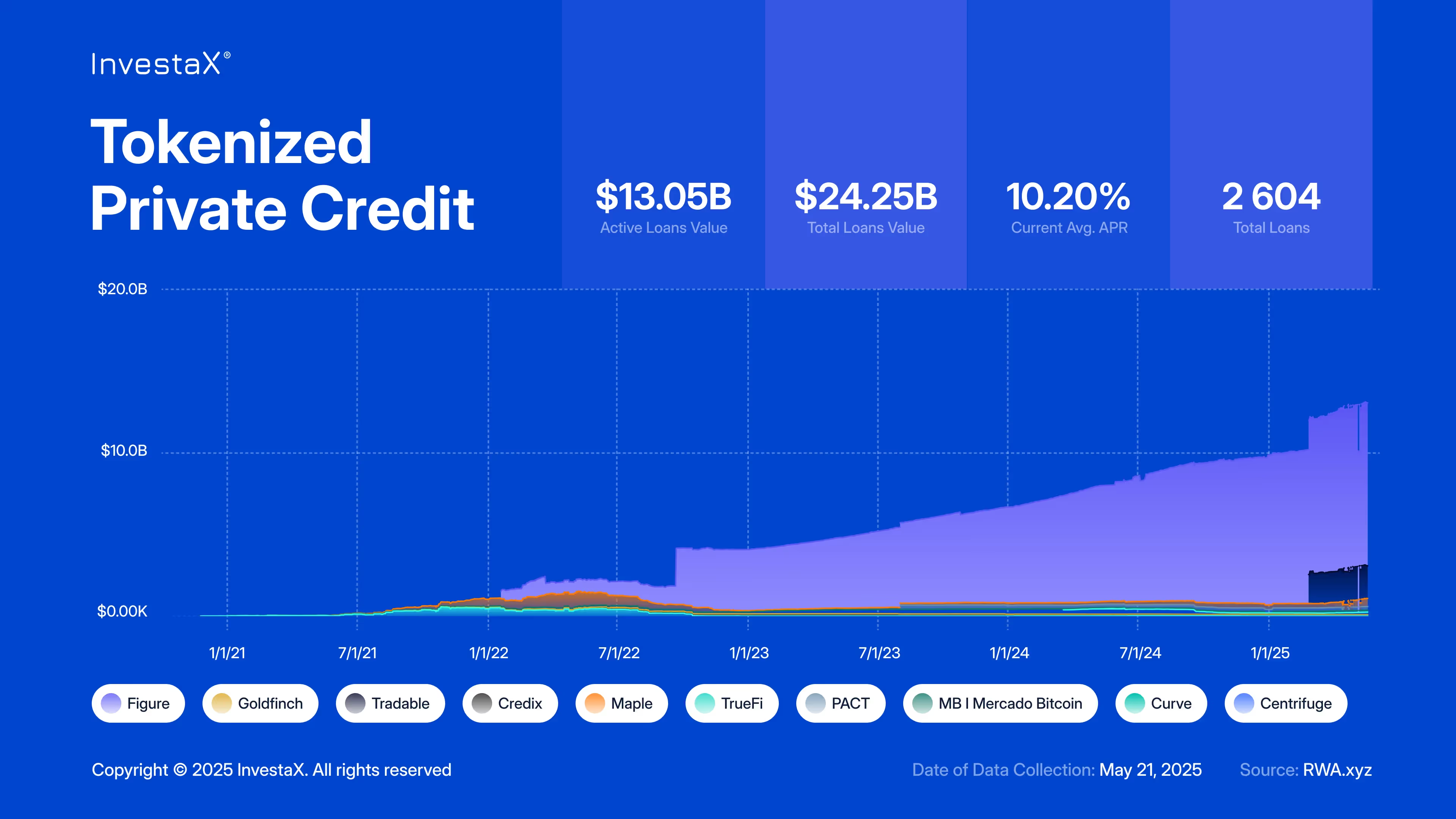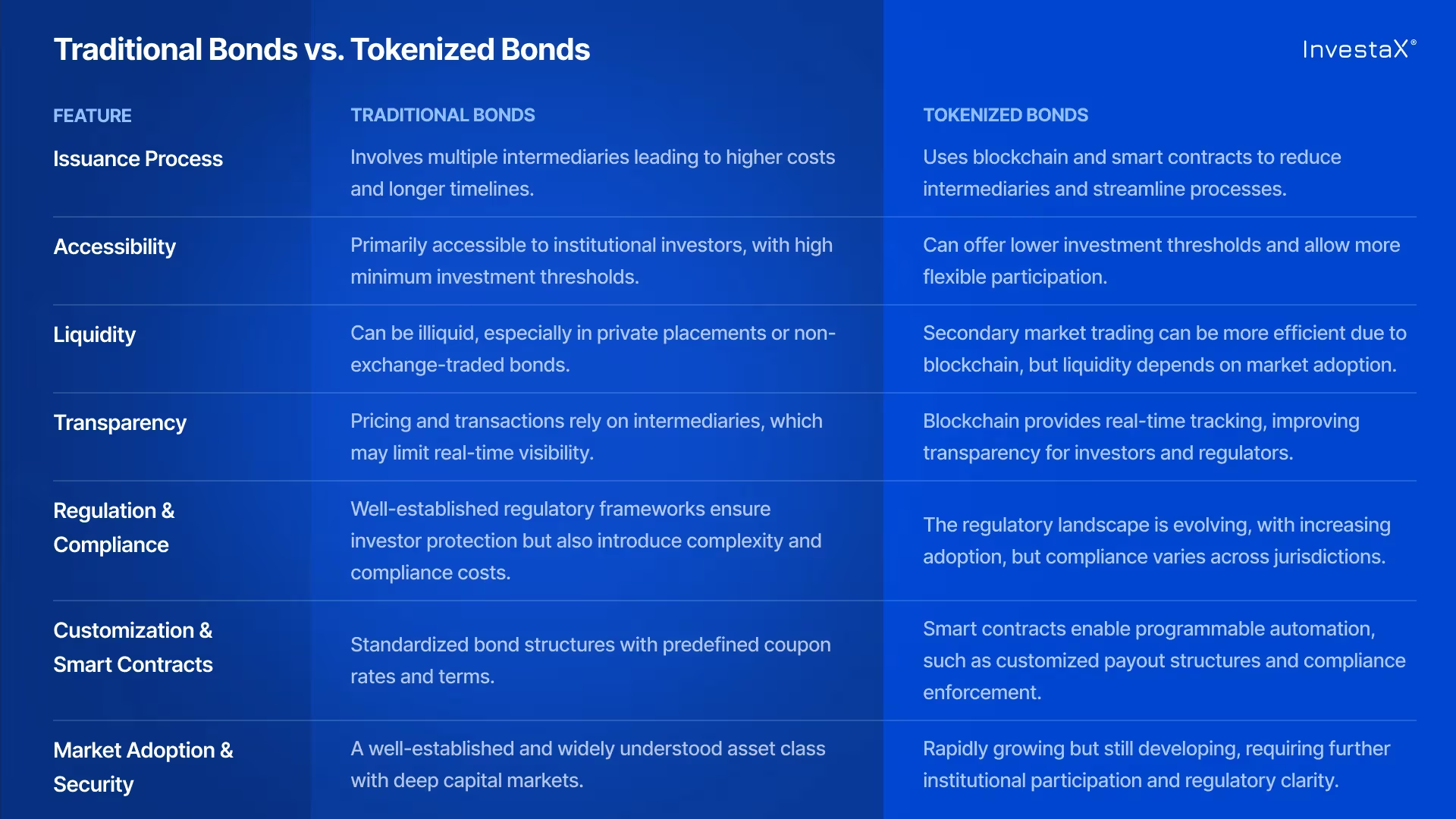The Evolution of Bonds: From Traditional to Tokenized
The global bond market has long been a cornerstone of global finance. However, traditional bond issuance remains complex, costly, and time-consuming, relying on intermediaries such as banks, custodians, and clearinghouses.
Today, bond tokenization is reshaping the $141 trillion fixed-income market (JP Morgan, December 2024), allowing issuers to digitize bonds on blockchain networks, increasing efficiency, reducing costs, and broadening investor access. As of May 2025, tokenized private credit has reached $13 billion, leading the growth of the tokenized real-world asset sector.

Understanding Tokenized Bonds
Bond tokenization is the process of issuing digital tokens that represent specific rights to the underlying debt instrument. These digital tokens can represent ownership, economic entitlements (such as interest payments and principal repayment), or other contractual rights associated with the bond.
Tokenized bonds are digital representations of traditional bonds, issued and managed on blockchain infrastructure.
Tokenized bonds retain all traditional bond characteristics (principal, interest rate, maturity date) while leveraging blockchain for security, transparency, and efficiency.
Traditional Bonds vs. Tokenized Bonds
Bond tokenization eliminates many inefficiencies in bond markets, allowing sovereign issuers, corporate issuers, real estate firms, and private credit funds to issue bonds with fewer barriers and greater investor reach.

A key advantage of tokenized bonds is the streamlined issuance process. Traditional bond issuance involves multiple intermediaries, such as arrangers, dealers, custodians, and clearinghouses, resulting in higher costs and longer timelines.
Tokenization replaces these with blockchain-based infrastructure and smart contracts, automating the bond’s lifecycle and settlement. These efficiencies reduce costs and can translate into higher yields for investors.
Look at the visual comparison below!
.avif)
Some of the insights in this blog post are drawn from the webinar "The Power of On-Chain Bonds: Insights and Strategies," co-hosted by InvestaX and Obligate, with featured speakers from Mikro Kapital and TradeFlow Capital Management. For the full discussion, watch the webinar recording here.
Real-World Examples of Tokenized Bonds
1. Corporate Bonds – Les Constructeurs du Bois
Les Constructeurs du Bois, an Euronext-listed eco-friendly real estate company, has tokenized its corporate bond eNote™. The bond finances the company’s organic growth and supports working capital for new ecological real estate projects, which utilize bio-sourced materials and local supply, offering an ESG-themed investment opportunity.
Explore this tokenized corporate bond on InvestaX: Les Constructeurs du Bois
2. Private Credit Tokenization – TradeFlow Capital
TradeFlow Capital is a commodity trade finance fund founded in 2016 in Singapore, with a multi-year track record with stable returns, low volatility and zero defaults. TradeFlow has tokenized its private credit note, offering investors exposure to pre-booked, insured commodity transactions. This structured debt instrument provides stable returns with risk mitigation, demonstrating how tokenization improves access to alternative fixed-income assets.
Explore TradeFlow Capital’s tokenized private credit on InvestaX: eNote™ - TradeFlow Capital Management Fund
3. Private Credit Tokenization – Mikro Kapital
Mikro Kapital, an established microfinance investment firm, has tokenized its ALTERNATIVE eNote™, giving investors exposure to SME lending in emerging markets. The asset-backed structure aligns with impact investing trends, supporting financial inclusion while offering strong risk-adjusted returns.
Learn more about Mikro Kapital’s tokenized private credit on InvestaX: eNote™ - ALTERNATIVE by Mikro Kapital
Others Notable Tokenized Bond Deals
- World Bank’s Bond-i: First blockchain-based bond, issued on Ethereum for $18M, used for sustainable development projects (World Bank, 2018).
- Siemens’ Corporate Bond: €60M one-year bond issued on Polygon, showcasing corporate adoption of blockchain for capital efficiency (Ledger Insights, 2023).
- Slovenia’s Sovereign Bond: In July 2024, Slovenia issued $32.5 million in digital bonds through digital ledger technology, becoming the first European Union nation to issue sovereign digital bonds (Ministry of Finance, 2024).
- Hong Kong’s Digital Green Bond (2023, 2024): The Hong Kong Special Administrative Region (HKSAR) Government issued its first tokenized green bond in February 2023, denominated in HKD and valued at approximately US$100 million. The second issuance of Hong Kong's digital green bond worth HK$6 billion happened in February 2024 (ICMA, 2024).
How Tokenized Bonds Are Issued
1. Structuring & Regulatory Compliance
The issuer (a corporation, government, or fund) works with legal and regulatory experts to structure the tokenized bond, ensuring compliance with securities laws.
2. Tokenization & Smart Contract Development
A smart contract is created on a blockchain, representing the bond’s terms, including coupon payments, maturity dates, and investor rights.
3. Distribution & Investor Access
The tokenized bond is listed on a regulated platform like InvestaX, allowing accredited investors, asset managers, and institutional players to participate.
4. Trading & Secondary Market Liquidity
Once issued, tokenized bonds can be traded on a regulated secondary marketplace like InvestaX’s IX Exchange, increasing liquidity and accessibility for investors.
Why Issuers Are Turning to Bond Tokenization
1. Lower Costs and Faster Issuance
Traditional bond issuance involves multiple intermediaries and weeks of processing. With tokenization, issuers can reduce fees, shorten timelines, and streamline the process.
2. Improved Liquidity and Accessibility
Tokenized bonds can be fractionalized, allowing investors to trade smaller units in a more liquid market. This is particularly beneficial for private credit funds, alternative investment managers, and real estate firms.
3. Transparency and Security
Smart contracts automate payments and reduce counterparty risk, ensuring real-time verification of transactions on the blockchain.
4. Regulatory Alignment and Institutional Interest
With central banks and regulators exploring tokenized bonds, such as Switzerland’s DLT law-compliant bonds and Singapore’s Project Guardian, market adoption is accelerating.
A Smarter Way to Issue Bonds Starts Here
Bond tokenization is no longer a future concept. As traditional capital markets face inefficiencies, corporate bond issuers, private credit funds, and institutional investors are embracing tokenization to modernize debt financing.
For issuers, tokenized bonds provide a direct, efficient, and scalable way to raise capital while improving investor access and liquidity.
For more information, please contact us here.